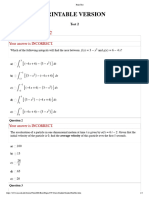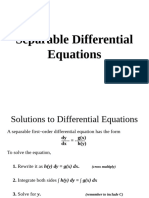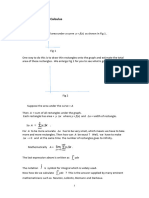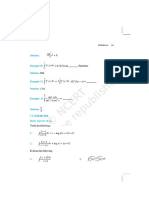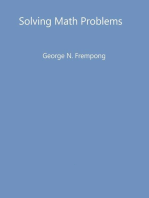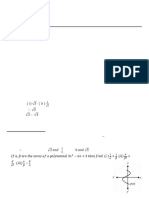Integral Calculus
Integral Calculus
Uploaded by
xranlikeabulletxCopyright:
Available Formats
Integral Calculus
Integral Calculus
Uploaded by
xranlikeabulletxCopyright
Available Formats
Share this document
Did you find this document useful?
Is this content inappropriate?
Copyright:
Available Formats
Integral Calculus
Integral Calculus
Uploaded by
xranlikeabulletxCopyright:
Available Formats
Centre for Continuing Education
MA-C4 Integral Calculus
Prerequisite knowledge
Differentiate the following:
a) y = 4x 4 − 7x 3 + 2x 2
b) y = (2 − 7x 3 )5
c) y = ln(4x 3 − 9x)
3
d) y = e4 x
e) y = 2sin3x
cos x
f) y=
x
g) y = tan 2 (3x)
1
h) y =
e x cos x
Solutions are on page 67.
HSC Preparation: Mathematics Advanced Part 3 5
Centre for Continuing Education
Anti-differentiation
Anti-differentiation is the reverse of differentiation. We write ∫ f (x) dx to indicate the anti-
derivative. This is also called an indefinite integral. We can use our knowledge of the
processes involved in differentiating functions to develop rules for the reverse process.
Derivative Rule Anti-Derivative Rule
d n
x = nx n−1
dx
d ax+b
e = ae ax+b
dx
d f '(x)
ln ⎡⎣ f (x) ⎤⎦ =
dx f (x)
d x
a = (ln a)a x
dx
Proof:
Note: all of the anti-derivative formulas include +c at the end. Why?
___________________________________________________________________________
HSC Preparation: Mathematics Advanced Part 3 6
Centre for Continuing Education
Anti-differentiation Practice Questions
Find:
∫x ∫ −2cos(x) dx
6
dx
∫ 6x − 3x + 2 dx x
2
∫ 3sec
2
dx
2
∫ x dx ∫ cos(2x) dx
∫e
−x
1 dx
∫ x 2 dx
∫ sin x dx ∫ 2e
3x−1
dx
HSC Preparation: Mathematics Advanced Part 3 7
Centre for Continuing Education
∫3 x
x
dx
∫ 6 − 4x 2
dx
2x x+2
∫ 3 dx ∫x 2
+ 4x
dx
1 ex
∫ x dx ∫ 3ex + 5 dx
1
∫ 5x dx ∫ tan x dx
6x 2x + 9
∫ 3x 2
−2
dx ∫ x+2
dx
Solutions are on page 67.
HSC Preparation: Mathematics Advanced Part 3 8
Centre for Continuing Education
The Reverse Chain Rule
Use the chain rule to complete the following:
Function Derivative
(3x + 1)2
(x 2 + 4)10
cos 2 x
sin 4 x
(x 3 + 1)3
(cos x + 2)4
(e2 x − 3)5
n+1
⎡⎣ f (x) ⎤⎦
Hence, complete the following:
Function Anti-Derivative
6(3x + 1)
10x(x 2 + 4)4
−2cos x sin x
4cos x sin 3 x
x 2 (x 3 + 1)2
sin x(cos x + 2)3
e2 x (e2 x − 3)4
n
f '(x) ⎡⎣ f (x) ⎤⎦
HSC Preparation: Mathematics Advanced Part 3 9
Centre for Continuing Education
n 1 n+1
The reverse chain rule states that ∫ f '(x) ⎡⎣ f (x) ⎤⎦ dx =
n +1
⎡⎣ f (x) ⎤⎦ + c .
n
Identify ⎡⎣ f (x) ⎤⎦ and f '(x) in the functions below and hence find the indefinite integrals.
∫ 4x (x − 3)6 dx
∫x
3 4 2
x 3 + 1dx
∫ 6x(3x + 2)4 dx ∫ x (3x + 1)3dx
2 4 5
∫ (15x − 3)(5x 3 − 3x)3dx ∫ cos x sin
2 3
xdx
∫ sin x(cos x + 2) ∫ cos x
3
dx sin x dx
∫ e (e − 1)3 dx ∫ x(x + 4)4 dx
x x 2
Solutions are on page 68.
Remember: constants DO NOT affect the differentiation or anti-differentiation process.
It is sometimes necessary to multiply and divide by constants in order to write the integral in
an easily identified form. It is NOT ok to multiply or divide by functions of x.
HSC Preparation: Mathematics Advanced Part 3 10
Centre for Continuing Education
Finding the original function
Given the derivative f '(x) of a function, the original function will be of the form f (x) + c.
In order to determine the equation of f(x), we need to determine the value of c, which will be
based on a given initial condition.
To find the original function:
1. Use anti-differentiation to find f(x) + c
2. Substitute in the given values
3. Solve the resulting equation to find c
4. Write the equation for the original function
Examples
dy
1. The gradient function of a curve is given by = 3x 2 − 12 .
dx
If the curve passes through (-3, 2), find the equation of the curve.
2. The gradient function of a curve y = f(x) is given by f '(x) = 4x − 5 . The curve
passes through the point (2, 3). Find the equation of the curve.
3. The derivative of a function f(x) is f '(x) = 4x − 3. The line y = 5x − 7 is a tangent
to the graph of f(x). Find the function f(x).
HSC Preparation: Mathematics Advanced Part 3 11
Centre for Continuing Education
Areas and Integration
The area under a curve is “the area between a function and the x-axis, bounded by two values
b
of the independent variable (x)”. If the function is positive, we write this area as ∫ f (x) dx.
a
Because of the irregular shape of most functions, this area is difficult to calculate using
geometric means. However, it can be approximated.
Example 1
Approximate the shaded area below:
(a) Using the left rectangles (b) Using the upper rectangles
_________________________________ ________________________________
(c) Using trapeziums
________________________________
________________________________
Which do you think is the best estimate?
How could the estimates be improved?
________________________________
________________________________
HSC Preparation: Mathematics Advanced Part 3 12
Centre for Continuing Education
The Trapezoidal Rule is one of the most common methods of approximation.
b
b− a
∫ f (x) dx ≈ ⎡⎣ f (a) + f (b) + 2 { f (x1 ) + f (x2 ) + ...+ f (xn−1 )} ⎤⎦
a
2n
Where, a = x0 and b = xn are the two bounding x-values, and the other values of xk are found
by dividing the interval [a, b] into n equal sub-intervals.
Q. Why is this formula called the Trapezoidal Rule? Where do the elements of this formula
come from?
In practice, a table-of-values can be really helpful.
Example 2
Use the Trapezoidal Rule, with 3 sub-intervals to approximate the area below.
HSC Preparation: Mathematics Advanced Part 3 13
Centre for Continuing Education
Example 3
A surveyor took 3 vertical measurements across a body of water at 10 metre intervals.
Use the Trapezoidal Rule twice to calculate an approximate area of the lake
Example 4
Use the Trapezoidal Rule to calculate an expression for the areas of the shaded and unshaded
sections in the diagram.
HSC Preparation: Mathematics Advanced Part 3 14
Centre for Continuing Education
Sometimes, geometric arguments can give an exact value of the area.
Example 5
Sketch y = x + 1 for 0 ≤ x ≤ 5.
Hence, find the area under the curve between x = 0 and x = 5.
Example 6
Sketch the area represented by ∫
−3
9 − x 2 dx .
Hence, find the area under the curve.
HSC Preparation: Mathematics Advanced Part 3 15
Centre for Continuing Education
The Fundamental Theorem of Calculus
b
The fact that the area is written as ∫ f (x) dx gives an indication of how we can find the exact
a
b
area under an irregular curve. ∫ f (x) dx = F(a) − F(b) , where F(x) is an anti-derivative of
a
f(x). This is called The Fundamental Theorem of Calculus.
Given a continuous function, f(x), we define the function A(x) as being the area under the
curve f(t) between a and x.
Then A(x+h) is the area between __________ and _____________.
Write an expression for the shaded area (in terms of A(x) and A(x+h)).
Shaded area = ________________________________________________________
The shaded area can be approximated by a rectangle with height f(x) and width h, so
A(x + h) − A(x) ≈ f (x) × h
HSC Preparation: Mathematics Advanced Part 3 16
Centre for Continuing Education
If m and M are the minimum and maximum values of f(x) in the interval between x
and x + h, then the shaded area is greater than ________ and less than __________.
m × h ≤ A(x + h) − A(x) ≤ M × h
or
m≤ ≤M
As h approaches zero, x + h approaches x and both m and M approach f(x). So,
lim = f (x) .
h→0
Note that by the definition of the derivative, f(x) is the derivative of A(x) or, A(x) is a
________________________ of f(x).
If F(x) is a known primative of f(x) then ____________________ for some constant c.
As x approaches a, A(x) approaches zero, so c = _____________.
Therefore A(x) = F(x) – F(a). If b > a, we can let x = b and then A(b) = F(b) – F(a), or
Note: This proof relies on the idea that f(x) is continuous over the interval in question.
HSC Preparation: Mathematics Advanced Part 3 17
Centre for Continuing Education
Definite Integrals
b
∫ f (x) dx is called a definite integral.
a
To find it, calculate the anti-derivative, then substitute in the end values.
Example 7
Evaluate the following.
9
∫ 6x − 4x + 2 dx
2
∫
1
x dx
∫ 2e
3x−1
dx
−1
3π
4
∫ cos(2x) dx
π
4
Sketch the graph of y = cos 2x between 0 ≤ x ≤ π and hence, explain the sign of the last
integral.
HSC Preparation: Mathematics Advanced Part 3 18
Centre for Continuing Education
The result in the last example highlights one of the many types of questions that can occur
when you are trying to find areas under or between curves.
Note: a definite integral can be negative, while an area cannot.
Function is positive over the interval
b
Area = ∫ f (x) dx
a
Function is negative over the interval
b
Area = ∫ f (x) dx
a
Function is a mixture of positive and
negative over the interval
Area is between 2 curves
Area is made up of multiple curves
Area is bounded by the y-axis
***ALWAYS SKETCH A GRAPH OF THE AREA YOU ARE FINDING FIRST***
HSC Preparation: Mathematics Advanced Part 3 19
Centre for Continuing Education
Example 8
Find the area enclosed by the curve y = 2 + x – x2 and the x-axis.
Example 9
Find the area bounded by the curve y = x2 – 4 and the x-axis.
HSC Preparation: Mathematics Advanced Part 3 20
Centre for Continuing Education
Example 10
Find the area enclosed by y = x3, the x-axis and the lines x = -2 and x = 3.
Example 11
Find the area between the curve y = x2 and the y-axis between y = 0 and y = 4.
HSC Preparation: Mathematics Advanced Part 3 21
Centre for Continuing Education
Example 12
Find the area enclosed by the curves y = x2, y = (x – 4)2 and the x-axis.
Example 13
Find the area enclosed by the curve y = x2 and the line y = x + 2.
HSC Preparation: Mathematics Advanced Part 3 22
Centre for Continuing Education
Areas bounded by special functions
Under what conditions is ∫
−a
f (x) dx = 0 ?
Sketch a function that satisfies this condition.
a a
Under what conditions is ∫
−a
f (x) dx = 2 ∫ f (x) dx ?
0
Sketch a function that satisfies this condition.
Without integrating, determine if each of the following is true or false. Give reasons.
1 1 1 1
∫ x + 2x dx = 2 ∫ x + 2x dx ∫ tan x dx = 2 ∫ tan x dx
4 2 4 2
−1 0 −1 0
1 1 1
∫ x − x dx = 2 ∫ x − x dx ∫ tan x dx = 0
3 3
−1 0 −1
1 1 1
∫ x dx = 0 ∫ e + e dx = 2 ∫ e + e dx
5 x −x x −x
−1 −1 0
Solutions are on page 68.
HSC Preparation: Mathematics Advanced Part 3 23
Centre for Continuing Education
Further Practical Applications of Integration
Remember:
dx d 2x
If x is the displacement of a particle, or x! is the velocity and 2 or x!! is the acceleration.
dt dt
Example 1
The velocity of a particle over time t seconds is given by v = 6t – 3 ms-1 and the particle is
initially 2 m to the left of the origin. Find the displacement after 4 s.
Example 2 (1992 HSC, Q8(b))
A particle moves so that its velocity, v metres per second, at any time t is given by v = e−2t .
Initially the particle is at x = 2.
a) Find the acceleration, a, of the particle as a function of time.
b) What is the acceleration of the particle after 1 second?
c) Find an expression for the displacement, x metres, of the particle in terms of t.
d) Find the distance the particle travelled during the first two seconds.
e) Describe what happens to the velocity of the particle for large values of t.
HSC Preparation: Mathematics Advanced Part 3 24
Centre for Continuing Education
Example 3 (1995 HSC Q4(c))
After heavy rain, the flood gate of a dam was opened. Water was released from the dam at a
rate of 31.8t litres per second where t is measured in seconds after the gate was opened.
a) Explain why the total volume of water, V, released from the dam in k seconds can be
k
found by evaluating the expression V = ∫ 31.8t dt.
0
9
b) Calculate the time it took for 10 litres of water to be released from the dam. Express
your answer to the nearest second.
Example 4 (1994 HSC Q3(d))
When heat was applied to a metallic disc for t seconds, its area, A cm2, increased at a rate
dA 2
given by = t − 2t + 1.
dt
a) At what rate was the area of the metallic disc increasing at the end of the third
second?
b) Before heat was applied, the area of a metallic disc was 10 cm2. Heat was applied to
this metallic disc for 3 seconds. What was the area of this metallic disc at the end of
three seconds?
HSC Preparation: Mathematics Advanced Part 3 25
Centre for Continuing Education
Exam Style Questions
Finding Integrals
1. Find ò 5x + 1 dx.
2. 6
Given that ò (x + k ) dx = 30, and k is a constant, find the value of k.
0
3. Find
ò5 dx.
4. 3
Find ò (x - 6)2 dx.
5. 4
òx
Find 2
+ x dx.
1
6. x
Find ò 4 + x 2 dx.
7. p
12
ò sec
2
Evaluate 3x dx.
0
8. dy
The gradient of a curve is given by = 1 – 6sin 3x.
dx
The curve passes through the point (0, 7).
What is the equation of the curve?
9.
10.
11.
12.
13.
Solutions are on page 69.
HSC Preparation: Mathematics Advanced Part 3 26
Centre for Continuing Education
Areas
1. (i) Sketch the curve y = ln x.
(ii) Use the trapezoidal rule with three function values to find an
3
approximation to ò ln x dx.
0
(iii) State whether the approximation found in (ii) is greater than or less
3
than the exact value of ò ln x dx. Justify your answer.
0
2. In the diagram, the shaded region is bounded by
y = loge(x – 2), the x-axis and the line x = 7.
Find the exact value of the area of the shaded region.
3.
The curves y = e2x and y = e–x intersect at the point (0, 1) as shown in the
diagram.
Find the exact area enclosed by the curves and the line x = 2.
4. The diagram shows the curve y =
1
, for x > 0.
x
The area under the curve between x = a and x = 1 is A1. The area under the
curve between x = 1 and x = b is A2.
The area A1 and A2 are each equal to 1 square unit.
Find the values of a and b.
HSC Preparation: Mathematics Advanced Part 3 27
Centre for Continuing Education
5. Use the Trapezoidal rule with 5 function values to find an approximation to the
1.5
ò (loge x)
value of 3 dx . Give your answer correct to three decimal places.
0.5
6. The diagram shows the graphs of y = 3 cos x and y = sin x. The first two
points of intersection to the right of the y-axis are labelled A and B.
(i) Solve the equation
3 cos x = sin x to find the
x-coordinates of A and B.
(ii) Find the area of the shaded region in the diagram.
7. A function ƒ(x) is defined by ƒ(x) = 1 + 2cos x.
2p
(i) Show that the graph of y = ƒ(x) cuts the x-axis at x = .
3
(ii) Sketch the graph of y = ƒ(x) for –p ≤ x ≤ p showing where the graph
cuts each of the axes.
p
(iii) Find the area under the curve y = ƒ(x) between x = – and
2
2p
x= .
3
8.
HSC Preparation: Mathematics Advanced Part 3 28
Centre for Continuing Education
9.
10.
11.
12.
13.
HSC Preparation: Mathematics Advanced Part 3 29
Centre for Continuing Education
14.
15. Find the area between the curves below
16.
HSC Preparation: Mathematics Advanced Part 3 30
Centre for Continuing Education
17. (SACE 2017 Mathematical Methods Q7)
Solutions are on page 70.
HSC Preparation: Mathematics Advanced Part 3 31
Centre for Continuing Education
Further Applications
1. (Mathematics HSC 2015 Q15(c))
2. (Mathematics HSC 2011 Q9(b))
3. (Mathematics HSC 2001 Q9)
4.
HSC Preparation: Mathematics Advanced Part 3 32
Centre for Continuing Education
5.
6.
7.
HSC Preparation: Mathematics Advanced Part 3 33
Centre for Continuing Education
8.
9.
10. (Mathematics HSC 2006 9(b))
11.
HSC Preparation: Mathematics Advanced Part 3 34
Centre for Continuing Education
12. (SACE Mathematical Studies 2016 Q16)
HSC Preparation: Mathematics Advanced Part 3 35
Centre for Continuing Education
13. (SACE Mathematical Methods 2018 Q6)
14. (SCSA WA Mathematics Methods 2018 Q20)
Solutions are on page 76.
HSC Preparation: Mathematics Advanced Part 3 36
You might also like
- Maths 12th Chapterwise Question Bank Nodia 2024Document369 pagesMaths 12th Chapterwise Question Bank Nodia 2024vijbhuNo ratings yet
- Calculus, Metric EditionDocument3 pagesCalculus, Metric Edition張洊翟No ratings yet
- Integrals Gatekeeper 16Document9 pagesIntegrals Gatekeeper 16Urmila PadmanabhanNo ratings yet
- Lec 1Document15 pagesLec 1Muhammed YasserNo ratings yet
- Test 2 - Fall 2016Document5 pagesTest 2 - Fall 2016mahmoodvolunteerNo ratings yet
- Chapter 1Document9 pagesChapter 1Angelo Paolo CamotaNo ratings yet
- DPP_04___Indefinite_Integration___Integration_By_Subs_NJ_247Document4 pagesDPP_04___Indefinite_Integration___Integration_By_Subs_NJ_247shubhanshmppt123No ratings yet
- IntegrationDocument9 pagesIntegrationtahsinhaideresha81No ratings yet
- CH - 5 WorksheetDocument2 pagesCH - 5 WorksheetFasiko AsmaroNo ratings yet
- MTS 201 181121 2021Document24 pagesMTS 201 181121 2021Godswill AdebayoNo ratings yet
- Lecture 4 - IntegrationDocument20 pagesLecture 4 - IntegrationALAHAKOON T.No ratings yet
- Math intergrationDocument11 pagesMath intergrationwilliamkaunda635709No ratings yet
- Introduction To IntegrationDocument2 pagesIntroduction To IntegrationPaul ThompsonNo ratings yet
- Worksheet NoDocument4 pagesWorksheet Noshhabalwhsh982No ratings yet
- Kuis 1 XII IPA Integral Tak TentuDocument3 pagesKuis 1 XII IPA Integral Tak TentuTefbana KehiNo ratings yet
- C 06 Anti DifferentiationDocument31 pagesC 06 Anti Differentiationebrahimipour1360No ratings yet
- NCERT Solutions For 13Document5 pagesNCERT Solutions For 13gowreeshvt33No ratings yet
- SEHH2250_Test_2_2425S1_sampleDocument13 pagesSEHH2250_Test_2_2425S1_samplelamlam1783No ratings yet
- 22.indefinate IntegrationDocument72 pages22.indefinate IntegrationJaysha GamingNo ratings yet
- Integration Webversion PDFDocument11 pagesIntegration Webversion PDFShashank S KudlurNo ratings yet
- Economia Matemática - Lista de Exercícios 1 - Integrais - 01-20Document4 pagesEconomia Matemática - Lista de Exercícios 1 - Integrais - 01-20Samuel CostaNo ratings yet
- MA10021 Exam ReviewDocument6 pagesMA10021 Exam Reviewjacobbwood2005No ratings yet
- Chapter 1-Part3Document11 pagesChapter 1-Part3mahmoudelsayad01013No ratings yet
- Math 001+Document10 pagesMath 001+Dali LinNo ratings yet
- Further Integration NotesDocument18 pagesFurther Integration NotesbfmsportsltdNo ratings yet
- IntegrationDocument1 pageIntegrationLinh ThuyNo ratings yet
- Differentiation (Day-5)Document4 pagesDifferentiation (Day-5)Faizan AnsariNo ratings yet
- MAT1110 Tutorial Sheet 9Document2 pagesMAT1110 Tutorial Sheet 9chimbaleonard66No ratings yet
- Integral CalculusDocument77 pagesIntegral Calculusnsnehasuresh83% (6)
- Mathematics Formula: Topic Phase-4Document14 pagesMathematics Formula: Topic Phase-4testerNo ratings yet
- Lecture 3 - Seperable First Order Differential EquationsDocument15 pagesLecture 3 - Seperable First Order Differential EquationsSaad2222No ratings yet
- Mth517 WK 11 Matlab: Integral CalculusDocument2 pagesMth517 WK 11 Matlab: Integral CalculusShavin ChandNo ratings yet
- Aula 3Document3 pagesAula 3SidsambangaNo ratings yet
- Integral CalculusDocument16 pagesIntegral CalculusSilvaSunnyNo ratings yet
- IntegralDocument13 pagesIntegralIvan SetyawanNo ratings yet
- 2.chain Rule of DifferentiationDocument7 pages2.chain Rule of DifferentiationShivamNo ratings yet
- Chapter 3 Integral Calculus 2024Document22 pagesChapter 3 Integral Calculus 2024Nizam AzhanNo ratings yet
- MIT18 01SC Pset3prbDocument9 pagesMIT18 01SC Pset3prbsachin rawatNo ratings yet
- Kalkulus UNDIPDocument31 pagesKalkulus UNDIPRosdian AriefNo ratings yet
- Integration-Indenite: Concepts and ProblemsDocument40 pagesIntegration-Indenite: Concepts and ProblemsUmesh ChaturvediNo ratings yet
- 03 BasicDerivativeRulesDocument2 pages03 BasicDerivativeRulesRebeca Enrique-CifresNo ratings yet
- integralDocument7 pagesintegralnbvcxzyklNo ratings yet
- Apni KakshaDocument22 pagesApni Kakshajayaburman05No ratings yet
- CALCULUSDocument1 pageCALCULUSRhea AgrawalNo ratings yet
- 201 Nya 05 2016 3Document4 pages201 Nya 05 2016 3rhl5761No ratings yet
- Worksheet - 1 Newton-Leibnitz FormulaDocument10 pagesWorksheet - 1 Newton-Leibnitz FormulaChetanNo ratings yet
- Calc I Sample Final 'B'Document1 pageCalc I Sample Final 'B'gbland100% (1)
- 2nd Year MathDocument2 pages2nd Year MathTalha hameedNo ratings yet
- class 12 Integrals MEQDocument14 pagesclass 12 Integrals MEQJeena JabezNo ratings yet
- Assign 3Document1 pageAssign 320230551No ratings yet
- Calculus 2-3 - 2-4 Review Worksheet AnswersDocument3 pagesCalculus 2-3 - 2-4 Review Worksheet AnswersBraggyyy BarreraNo ratings yet
- CALCULUS-II Lec Notes (Set 2)Document39 pagesCALCULUS-II Lec Notes (Set 2)mwendwakelvin842No ratings yet
- 21A Sample Final Solutions PDFDocument5 pages21A Sample Final Solutions PDFant314159No ratings yet
- 2018 - (I) Curso PenLogMat Medicina (Lista-03)Document7 pages2018 - (I) Curso PenLogMat Medicina (Lista-03)Anonymous K9tmd7T0PzNo ratings yet
- Tutorial 3Document2 pagesTutorial 3Olwethu NolieNo ratings yet
- 1332PracticeMidterm1 AsolutionDocument12 pages1332PracticeMidterm1 AsolutionWoo Sol YooNo ratings yet
- Derivatives: 1. Definition & NotationDocument6 pagesDerivatives: 1. Definition & NotationVivek GuptaNo ratings yet
- Mathematics 1St First Order Linear Differential Equations 2Nd Second Order Linear Differential Equations Laplace Fourier Bessel MathematicsFrom EverandMathematics 1St First Order Linear Differential Equations 2Nd Second Order Linear Differential Equations Laplace Fourier Bessel MathematicsNo ratings yet
- Factoring and Algebra - A Selection of Classic Mathematical Articles Containing Examples and Exercises on the Subject of Algebra (Mathematics Series)From EverandFactoring and Algebra - A Selection of Classic Mathematical Articles Containing Examples and Exercises on the Subject of Algebra (Mathematics Series)No ratings yet
- A-level Maths Revision: Cheeky Revision ShortcutsFrom EverandA-level Maths Revision: Cheeky Revision ShortcutsRating: 3.5 out of 5 stars3.5/5 (8)
- CH 3 Form EDocument4 pagesCH 3 Form Ewokofi9784No ratings yet
- Calc 6.11 PacketDocument4 pagesCalc 6.11 PacketbubbleteaNo ratings yet
- Adv. Math 1, 2023Document4 pagesAdv. Math 1, 2023Hancy TarimoNo ratings yet
- Instant Download Schaum’s Outline - Mathematical Handbook Of Formulas And Tables 5th Edition Murray R Spiegel PDF All ChaptersDocument36 pagesInstant Download Schaum’s Outline - Mathematical Handbook Of Formulas And Tables 5th Edition Murray R Spiegel PDF All Chaptersmeierfunez3c100% (1)
- Pipe Fitters GuideDocument86 pagesPipe Fitters GuideFerdie UlangNo ratings yet
- Analysis of RF Remote Security Using Software Defined Radio KeeLoqDocument65 pagesAnalysis of RF Remote Security Using Software Defined Radio KeeLoqaTOMicNo ratings yet
- Maths S6 Draft PDFDocument145 pagesMaths S6 Draft PDFMboniyeze Eric100% (1)
- (MAA 3.4) ARCS AND SECTORS - EcoDocument16 pages(MAA 3.4) ARCS AND SECTORS - Ecoeddy.etameNo ratings yet
- Christian Dufour 2008Document7 pagesChristian Dufour 2008oualid zouggarNo ratings yet
- Questions On Circular Functions and Trigonometry 1Document38 pagesQuestions On Circular Functions and Trigonometry 1Mbeng TatianaNo ratings yet
- Chap 7Document94 pagesChap 7Sh ShNo ratings yet
- RD Sharma Dec2020 Solution For Class 11 Maths Chapter 30 PDFDocument34 pagesRD Sharma Dec2020 Solution For Class 11 Maths Chapter 30 PDFjalpaNo ratings yet
- Beat Phenomenon - Vibration - Sys. Analys.Document5 pagesBeat Phenomenon - Vibration - Sys. Analys.Miguel CervantesNo ratings yet
- Maths Advanced Level Problem Solving (ALPS-5) - PaperDocument11 pagesMaths Advanced Level Problem Solving (ALPS-5) - Papersatyamkumarmalindia2005No ratings yet
- Functions and Prog StructureDocument12 pagesFunctions and Prog StructurebaddalasaihanshithaNo ratings yet
- DPP (31-35) 11th J-Batch MathsDocument20 pagesDPP (31-35) 11th J-Batch MathsRaju SinghNo ratings yet
- Setting Out 1 Notes Engineering Surveying, 5th EdDocument6 pagesSetting Out 1 Notes Engineering Surveying, 5th EdJoseph KaranjaNo ratings yet
- Cambridge IGCSE: Additional Mathematics 0606/22Document16 pagesCambridge IGCSE: Additional Mathematics 0606/22Debraj MondalNo ratings yet
- pom10sb_7_6Document7 pagespom10sb_7_6joyce.k.costaNo ratings yet
- Maths 1Document20 pagesMaths 1Priyanshi BhattarNo ratings yet
- 11th Maths EM 1st Mid Term Exam 2023 Original Question Paper Thenkasi District English Medium PDF DownloadDocument2 pages11th Maths EM 1st Mid Term Exam 2023 Original Question Paper Thenkasi District English Medium PDF DownloadsuyambueswarisNo ratings yet
- 5-2 Verifying Trigonometric Identities PDFDocument48 pages5-2 Verifying Trigonometric Identities PDFRene DescartesNo ratings yet
- Novel Mechatronics Design For A Robotic Fish: Jindong Liu, Ian Dukes, Huosheng HuDocument6 pagesNovel Mechatronics Design For A Robotic Fish: Jindong Liu, Ian Dukes, Huosheng HuRaunak GuptaNo ratings yet
- 1920 - Mock - S6MA (M2) - v1 (Q&A BK)Document28 pages1920 - Mock - S6MA (M2) - v1 (Q&A BK)pgpcj68rsqNo ratings yet
- Teacher's Guide To GCSE Maths Revision MatsDocument8 pagesTeacher's Guide To GCSE Maths Revision Matskawthar lehamNo ratings yet
- Delhi Public School Secunderabad, Nacharam Chapter Wise Important QuestionsDocument16 pagesDelhi Public School Secunderabad, Nacharam Chapter Wise Important Questionsdarshan.b0208No ratings yet
- Worksheet To Print TrigonometryDocument2 pagesWorksheet To Print TrigonometryokhlobystinNo ratings yet
- Mathematics p2 Grade 11 November 2024, Memo-1Document17 pagesMathematics p2 Grade 11 November 2024, Memo-1Bulelwa SbahleNo ratings yet




